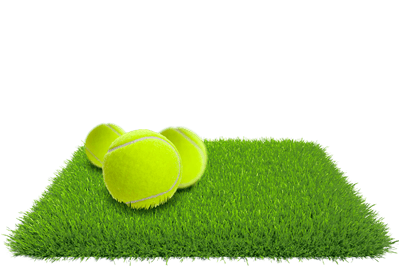Build a tennis court: the complete guide by Italgreen
Are you thinking of building a tennis court? Well, you can ask Italgreen how to do it in the best way. Since 1983 we have been offering a high-quality service for the design, the construction and the maintenance of a turnkey tennis court. Discover on this page all the steps to build a tennis court, how we do it, the most suitable kinds of synthetic grass and how to maintain it perfectly.
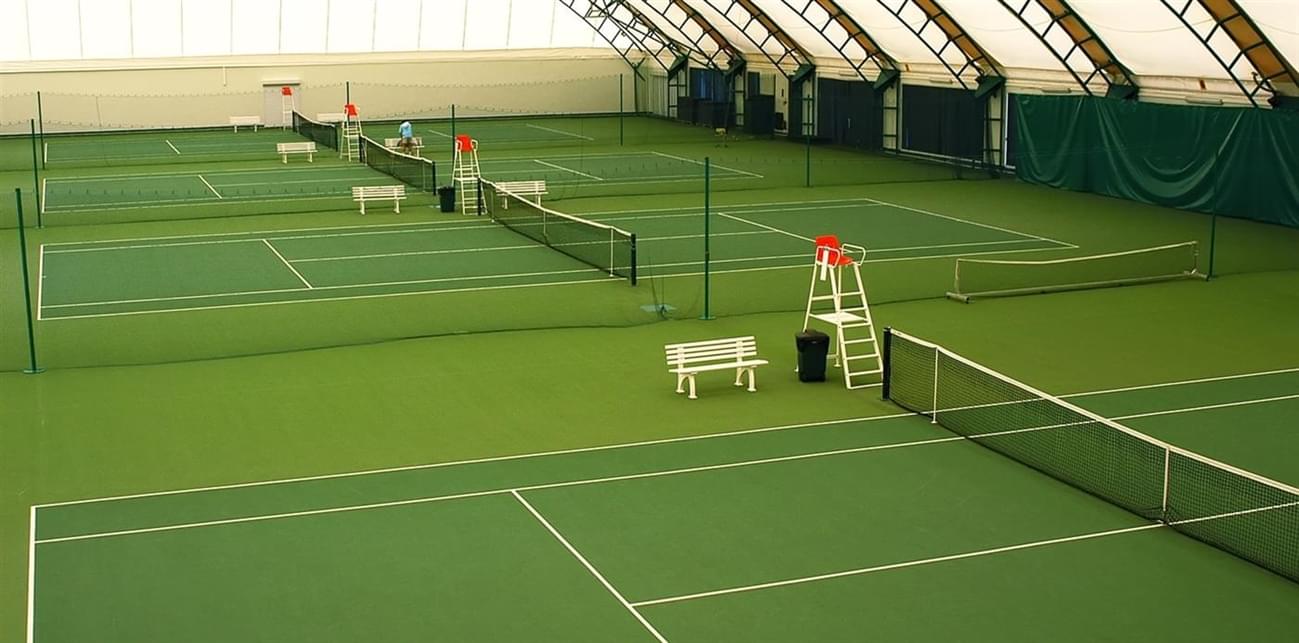
Build a tennis court – table of content:
- The parameters to consider to build a tennis court
- How Italgreen operates
- The location for your tennis court installation
- Optimal tennis court orientation and weather conditions
- The synthetic grass we recommend
- The advantages of artificial grass
- Our maintenance service after we have built your tennis court
BUILD A TENNIS COURT: PARAMETERS TO CONSIDER
Italgreen has been designing and building tennis courts for over 30 years using high-quality synthetic grass. This material ensures optimal bounce and year-round viability with minimal maintenance, as well as exceptional aesthetic performance.
There are several parameters to consider when designing and building a tennis court: specific measures of the playing field, lines and dividing network with their supports, must be adhered to. In addition, regulations regarding the design of the lighting system should be carefully considered.
How much space do you need to build a tennis court?
The minimum recommended size for building a tennis court that hosts either singles or doubles matches is 120 ft. by 60 ft. This is necessary for you to have enough space for the court itself, and room for players to overrun at the sides or serve from the baseline.
However, if what you look for is a proper tournament style court that includes room for judges and linesmen, add another 10 ft to each of the above measurements.
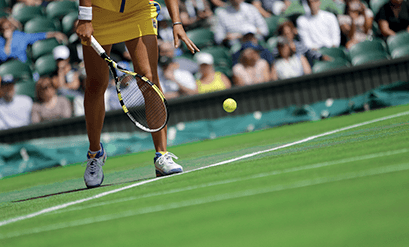
Wherever you come from, contact us and start building your tennis court
How we operate when we build a tennis court
We have being building tennis courts since the 1980s so that we have achieved some awards from FIT (Italian Tennis Federation). But do not be tricked by this – we are an international company that works and builds tennis courts worldwide, from Italy to the UK, from the USA to Japan.
Find here all our worldwide references.
We take our job seriously. When you contact us, we will start a step-by-step process to build and deliver you the best tennis court ever. Here’s how we operate in the concrete.
Step 1: Topographic and Feasibility Survey
Before building a tennis court, we need to check the suitability of the location area of the court, that is:
- Accessibility: check for adequate access for construction vehicles and equipment, as well as future maintenance access.
- Utilities and services: confirm the availability of key utilities such as water supply, electricity, and appropriate water collection and disposal systems, which are essential for court maintenance and lighting.
- Orientation of the playing field: an important aspect of tennis court design and construction is the orientation of the playing field. Ideally, the court should be positioned north-south to reduce glare and sun interference during play.
- Soil morphology and dominant winds: soil type affects drainage and stability, so proper assessment is necessary to ensure a long-lasting court. Also, understanding dominant winds helps in designing wind protection and determining optimal positioning for play.
Step 2: Preparing the Ground
The preparation of the ground for the placement of synthetic grass proceeds with the stratification of a layer of different measures to ensure maximum performance and draining properties. Everything must be surrounded by a containment wall that also acts as a support for the external fence:
- Layer stratification: layers of varying materials, such as gravel and crushed stone, are laid to facilitate maximum performance and drainage. This foundational layer ensures that water is properly managed, reducing risks of flooding or puddling.
- Containment wall: the perimeter must be enclosed with a containment wall, which will serve a dual purpose as support for external fencing and to retain the court's structure, especially for outdoor courts exposed to natural elements.
- Ground leveling and slope: proper leveling of the court surface is critical. While the court should be flat for play, a slight slope (usually around 1%) ensures that water drains away efficiently without affecting gameplay.
Step 3: Installing Synthetic Grass
The next step in building a tennis court is the laying of the synthetic turf, which can be selected between different types to create the best aesthetic effect. The synthetic lawn has at least a couple of considerable advantages: it won’t easily wear out, and it keeps a perfect performance hold for several years.
Synthetic turf installation is the core of our activity, and it involves:
- Underfelts and anti-shock layers: provide a cushiony feel and minimize shock for players.
- Fences and barriers: ensure that the court is safely enclosed, preventing stray balls and enhancing security.
- Irrigation systems and drainage: proper irrigation ensures that the turf stays in optimal condition. Drainage systems are equally important for preventing water accumulation.
- Infills and turf mantles: the turf is filled with sand or rubber granules to provide better grip, ball bounce, and player comfort.
Step 4: Installing Auxiliary Structures
The fifth step in building a tennis court is setting up auxiliary structures, enhancing the court’s functionality and player experience.
Depending on your request, various additional elements can be installed:
- Complementary works: from seating to pathways, these structures ensure a comfortable and accessible environment for players and spectators.
- Lighting systems: proper lighting allows for extended play hours, especially in indoor or evening games.
- Equipment and accessories: this includes net posts, ball catchers, and other essential playing accessories.
- Indoor court constructions: for indoor tennis court design and construction, tension fabric structures or similar coverings can be added to shelter the court from weather conditions, ensuring year-round playability.
Step 5: Post-Construction Care and Maintenance
After constructing your tennis court, it’s vital to develop a maintenance plan to retain its quality and performance over time. For synthetic courts, regular brushing, infill replacement, and cleaning ensure that the surface remains playable and safe.
Consider the location for your tennis court installation
When planning to build a tennis court, it's crucial to find the right location on your property. This will ensure there's enough space not only for the court itself, which measures 60 by 120 feet for doubles play, but also for additional elements like fencing, landscaping, and drainage.
Moreover, it's essential to be aware of local rules and regulations:
- Check local municipality rules for any specific regulations or permits required for court installation.
- Consider fencing and lighting restrictions, especially if you're part of a homeowners association (HOA), which might require board approval.
- Avoid fines and penalties by consulting with all relevant local authorities and organizations beforehand.
Ensuring compliance with all local guidelines and space requirements will help create a seamless installation process for your tennis court.
Optimal tennis court orientation and weather conditions
Choosing the right orientation and considering weather patterns are critical when planning your outdoor tennis court. A north-south orientation is preferred to prevent players from facing direct sunlight, which can impair visibility during play. Additionally, the court's location should account for local climate conditions to avoid water pooling from rain or snow by potentially lowering the surrounding land for better drainage.
Key strategies for non-ideal orientations include:
- Utilizing windscreens or shade structures to mitigate sunlight impact.
- Planting trees or shrubs for natural shade and wind protection.
- Installing movable panels for temporary relief from direct sun.
Considering the elevation, local weather patterns, and existing winds will ensure your tennis court provides a comfortable and playable environment throughout the year, regardless of your region's specific challenges.
Green HD, the best synthetic grass to build a tennis court
As we have written above, synthetic grass is our business core, so let’s spend a few words on some suggested kinds of artificial grass to build a tennis court.
Synthetic grass ensures a playability very similar to that of professional fields with much lower upfront costs and maintenance. The building of a synthetic turf tennis court, together with a perfect uniformity of the level of illumination, allows to make the plant highly usable and quickly re-enter the investment.
The advantages of synthetic grass are countless:
economical, practical, functional and aesthetical
The kinds of synthetic grass we suggest the most when building a tennis court is Green HD. We have installed Green HD in thousands of fields worldwide. It is a versatile artificial grass suitable for various applications, including tennis courts.
We have recently revisited it to provide a realistic two-color scheme in order to achieve the best aesthetic performance. This mantle is characterized by a smooth yarn that guarantees:
- superior elastic memory
- high resistance
- extreme duration
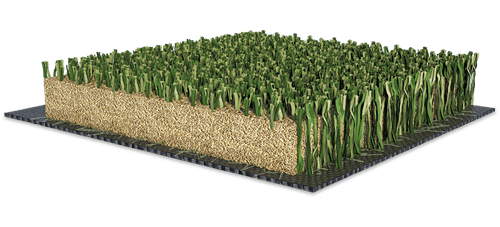
Why we use synthetic grass to build a tennis court
As you could see, the main material we use to build a tennis court is synthetic grass, that is a kind of artificial grass which:
- requires minimum maintenance efforts and costs
- allows the tennis court to be used all year long – even after heavy rains
- allows optimal ball bounce, very similar to clay courts
- provides perfect grip and foot slide
- has an excellent playing comfort
In a nutshell, it minimises costs and maximises performance. In addition, it looks like a natural grass field.
After building your tennis court: maintenance
Synthetic turf requires very low maintenance and guarantees excellent performance all year long, and that is the main reason why we use it in building a tennis court.
As a matter of fact, its maintenance is made of very few steps:
- Regular cleaning
- Periodic sanitation
- Periodic irrigation
- Watering on hot days
- Periodic repairs
- Periodic testing
In addition to this regular maintenance you can carry out by yourself, you may need some extra-ordinary intervention. In fact, we do not simply build tennis courts: upon request, we provide you with a maintenance service to ensure the long duration of the synthetic turf mantle.
This special maintenance is called Italgreen Care and by joining the program you can get:
- some discount on maintenance interventions and the purchase of infills
- free site inspections
- warranty extension
- membership card with the special Italgreen Customer Kit
Looking for a trusted partner to build your new tennis court?
- Via Crusnigo, 11
- 24030 Villa d'Adda (Bergamo)
- VAT number: IT01640880165
- Cod. Fiscale 07075130158
- Cod. Destinatario SUBM70N
- Shared capital: € 5,000,000
- REA BG 214799
- Phone number: +39 (035) 784-178
- Fax: +39 (035) 784-144
- Email: contact@italgreen.it
- PEC: italgreen@mailcertificata.org
- CLICK HERE to Whistleblowing
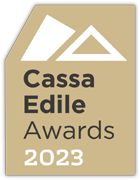
- Padel
- Artificial lawn
- Padel courts: benefits, construction and installation
- Build a tennis court: the complete guide by Italgreen
- Artificial grass manufacturers and suppliers
- Synthetic grass tennis court: benefits and supply
- Padel
- Artificial grass for sports
- Artificial grass manufacturers
- Sports artificial grass
- Synthetic grass manufacturer
- Italgreen: golf turf manufacturers and suppliers since 1983
- NEW LIMITED EDITION PADEL COURTS
- Padel court manufacturers: why choose Italgreen
- Sports turf manufacturers since 1983
- Indoor padel courts
- Italgreen’s synthetic soccer field
- The steps to replace the synthetic grass for padel
- Hybrid Turf
- High-quality artificial sports turf manufacturer
- Padel court supplier
- Artificial grass factory: Italgreen is at your disposal
- Soccer turf installation: a guide by Italgreen
- Padel court maintenance
- Synthetic Turf Suppliers
- Padel court builder: Italgreen is the solution
- Comprehensive guide to synthetic soccer turf: benefits, installation, and maintenance
- Field hockey turfs: a comprehensive guide
- Padel Court Design, Project, and Installation
- Artificial football turf
